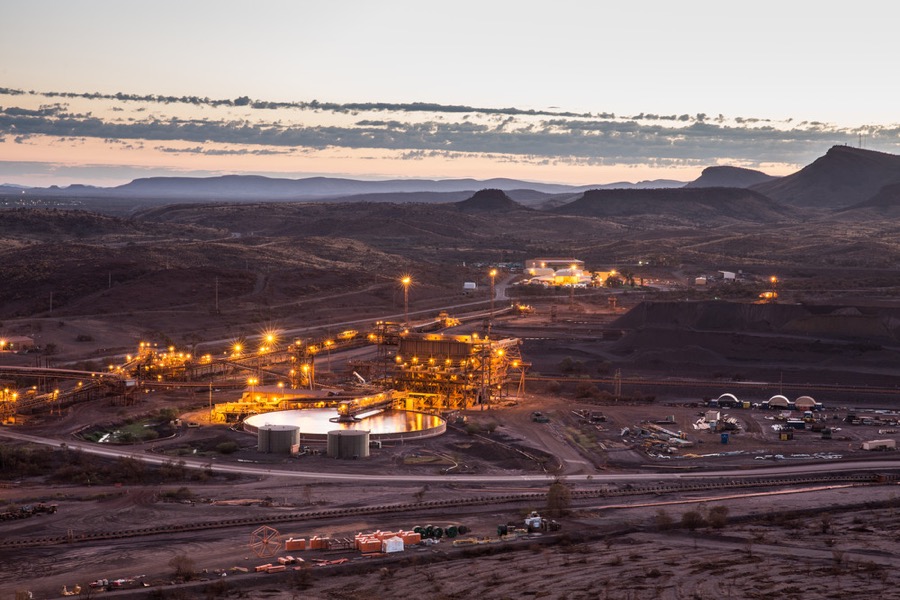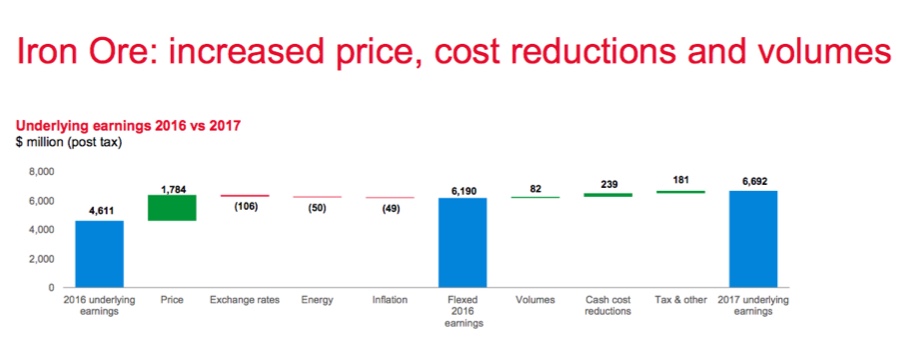
Rio Tinto (ASX, LON, NYSE:RIO), the world’s No.2 mining company, showed investors Wednesday how well it has ridden the wave of higher commodity prices by announcing a record dividend on the back of a big surge in annual profit and its cost cutting drive.
Bumper results came on the back of a recovery in the price of key commodities for Rio Tinto, including iron ore, aluminum and copper.
The company, which admitted is hunting for acquisitions, including in new commodities such as lithium, handed shareholders $1.80 per stock, taking its payout for 2017 to $2.90. The figure is the highest in Rio’s history and almost 71% more than the one it paid last year. As a result, cash returns to investors for 2017 totalled $9.7 billion.
Net profit for the year rose 90% (you read that right) to $8.8 billion, compared to the $4.6bn recorded in 2016. Underlying net profit after tax, in turn, was $8.62bn, up from $5.1bn in 2016, slightly ahead of market forecasts. Analysts expected the company to report $8.5bn.
Rio’s largest division, iron ore, delivered the lion’s share of revenue, as prices have recovered and remained relatively stable — trading around $75 a tonne — in the past year.
The record results are the first annual report for chief executive Jean-Sébastien Jacques, who took over from former boss Sam Walsh in July 2016.
Under Jacques, Rio has focused on cutting costs, generating cash and returning as much of it as possible to investors through dividends and share buybacks.

Iron ore accounts for almost 90% of Rio’s earnings. (Taken from: Rio Tinto’s 2017 Full Year Results Presentation.)
“I’m very proud of what the team has achieved. Biggest dividend ever in the 125-year history of the company and we believe that we’ll be able to generate a lot of cash again this year,”Jacques told reporters on an earnings call.
With net debt below $4 billion, Rio Tinto is once again in a position to look for fresh opportunities and projects. But analysts, including Investec’s mining expert Hunter Hillcoat, believe Rio is unlikely to embark on any “multibillion-dollar expansions” to chase mergers and acquisitions or pay a premium for other commodities, such as copper, given the industry’s history of overspending.
“The only way to rebalance their portfolio is to take on additional growth in other commodities like copper, either through acquisitions where they’ll have to pay a premium or through expansion, but they don’t really have too many meaningful growth options there,” Hillcoat told Bloomberg News.
Despite the positive results, the company is still battling reputational damage brought by a series of incidents, including a probe into a questionable payment made to an external consultant over the Simandou iron ore project in Guinea.
It is also facing fraud charges from the US Securities and Exchange Commission (SEC), the country’s top securities regulator, related to the miner’s and two former executive’s alleged covered-up of multi-billion-dollar losses on a coal investment in Mozambique, allegations which the two men and the company deny.
Rio has also been recently accused of dodging $700 million in taxes at its massive Oyu Tolgoi copper and gold mine in Mongolia.
Comments
marpy
First of all, Tinto owns about 1/3 of that massive mine in Mongolia through its 51% ownership in TRQ (TRQ owns 2/3) with the Mongolian government owning the other 1/3. Tinto also has other issues related to the Mongolian mine as the other large minority shareholders spearheaded by Sailing Stone, are not to happy with the way Tinto has been managing the operation. They say they want to expand in copper and other metals but the future seems to be pointingthem in the opposite direction with the Indonesian government taking over operations in that country , other mines being old and looking at lower grades and Tinto doing little to increase its ownership in growth prospects like the large Mongolian mine. They are still extremely dependant on Iron ore and based on what seems to be currently happening will be even more dependant on Iron ore in the future.